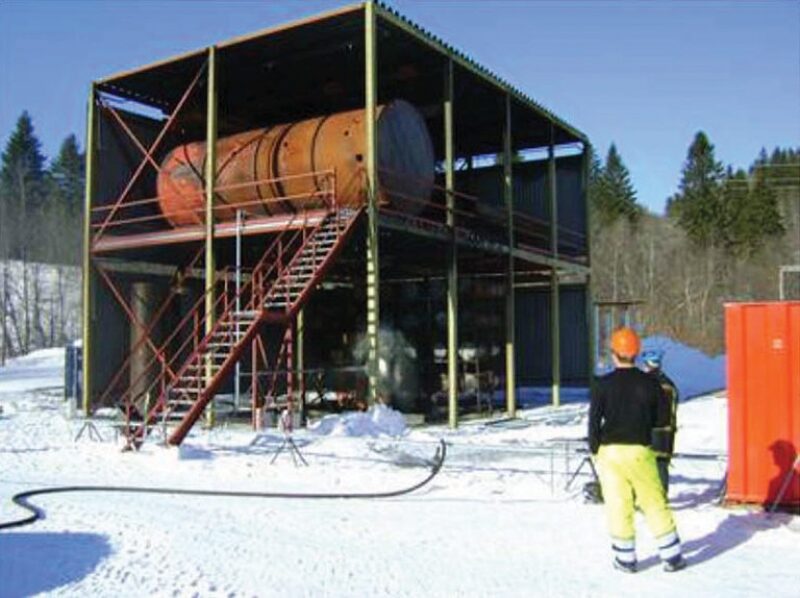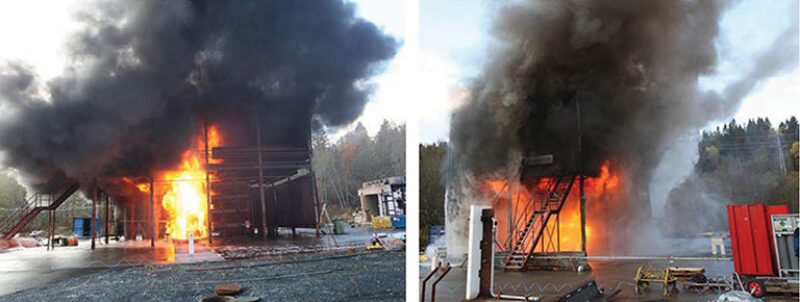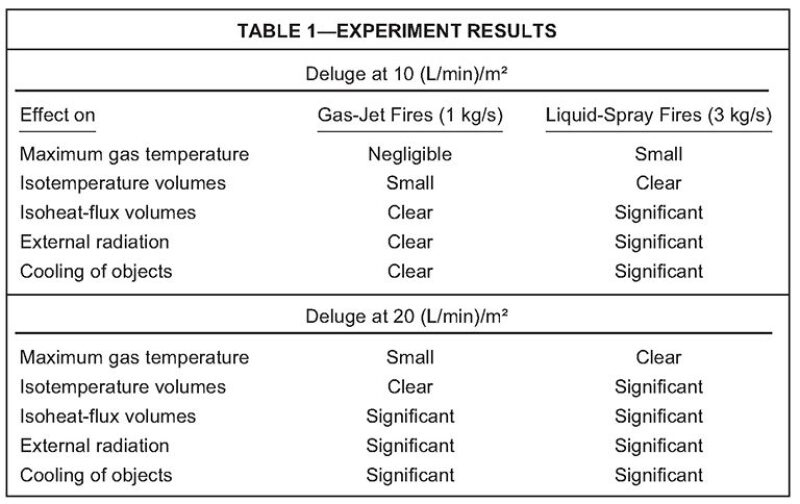A series of 56 large-scale fire experiments in the range of 40–120 MW has been carried out in a generic offshore module. The effect of deluge fire-water application has been measured for different setups. Both deluge nozzle type and water-application rate have been varied in the experiments.
Introduction
The use of water-spray systems for firefighting is standard for most offshore oil and gas installations. The requirements to and guidelines for control and mitigation of fires are stated in International Organization for Standardization (ISO) 13702, Petroleum and Natural Gas Industries—Control and Mitigation of Fires and Explosions on Offshore Production Installations—Requirements and Guidelines. Appendix C in ISO 13702 lists the recommended fire-water-application rates for areas and rooms on an oil- or gas-production installation. Typically, the minimum recommended water-application rate is listed as 10 (L/min)/m2. NORSOK Standard S-001, applicable for installations on the Norwegian continental shelf, states that the effect of deluge may be taken into account for process equipment and piping, provided that there is proper documentation of the fire-water effect (and that there are requirements to the reliability of the fire-water system).
In order to document the effect of the recommended fire-water-application rate, a set of full-scale fire experiments with application of fire water was carried out at SINTEF NBL.
Background
Today’s design of oil- or gas-production installations includes deluge-fire-water systems as standard. These are costly and may require extensive maintenance. Despite the costs involved, little knowledge is available on the actual effect of fire-water systems under different operating conditions.
Appendix C in ISO 13702 recommends a typical water-application rate of 10 (L/min)/m2. National Fire Protection Association (NFPA) 15: Standard for Water Spray Fixed Systems for Fire Protection recommends a design objective for control of burning of not less than 20 (L/min)/m2. NORSOK S-001 refers to NFPA 15 but prescribes 10 (L/min)/m2 for process areas and equipment surfaces and 20 (L/min)/m2 for the wellhead area. American Petroleum Institute (API) 2030, Guidelines for Application of Water Spray Systems for Fire Protection in the Petroleum Industry, prescribes 20 (L/min)/m2 where pumps are present and 10 (L/min)/m2 for pipe racks and piping. To what extent do these water-application rates actually affect the fire?
Quantification of Fire Loads
The characteristics of a fire are not trivial to measure. Different ways of measuring fire characteristics include
- Ability to extinguish fire
- Total heat-release rate (HRRtot), kW
- Convective heat-release rate (HRRcon), kW
- Total flame volume, m3
- Maximum flame temperature, °C, K
- Flame volume above a defined temperature (e.g., V at >1000°C), m3
- Maximum local heat fluxes, kW/m2
- Maximum global heat fluxes, kW/m2
- Flame volume above a defined heat flux (e.g., V at >250 kW/m²), m3
- Surface emissive power of a flame, kW/m2
- Temperature or temperature rise of flame-exposed objects, °C, K; or °C/s, K/s
- Smoke production, m3/s, g/s
In a full-scale field experiment, many of these parameters are difficult or impracticable to measure. However, most of them are possible to derive from fire simulations using suitable software.
Experimental Setup
The 56 fires were in the range of 40–120 MW. The experiments were carried out in a 15×10×10-m generic process module (Fig. 1).

The process module was equipped with nearly 200 thermocouples, 100 of which measured gas temperature. The rest measured temperature of equipment, structure, and exhaust gas.
Parameter variations addressed during the experiments were
- Hydrocarbon media (propane, diesel)
- Hydrocarbon leak rate (1 kg/s, 3 kg/s)
- Leakage location
- Leakage direction
- Water-application device (medium-velocity nozzles, high-velocity nozzles, high-capacity nozzles, and monitors)
- Water-application rate [10 (L/min)/m2, 20 (L/min)/m2]
- Enclosure
- Wind
- Additives
Pictures of a 3-kg/s diesel-spray fire before and after activated deluge can be seen in Fig. 2.

Results
Here the fire-water effects are presented at a semiquantitative level on the basis of measured values before and after deluge water application.
The effect on maximum gas temperature is measured as K/K as an average of the 10 thermocouples with the highest readings. The effect on isotemperature volumes is a qualitative assessment based on ratios calculated as m3/m3 for volumes with temperatures higher than 1100 and 1000°C. The effect on isoheat-flux volumes is a qualitative assessment based on ratios calculated as m3/m3 for heat-flux levels larger than 250, 200, and 150 kW/m2. The effect on external radiation level is based on ratios of heat flux derived from simulations.
A “negligible” effect indicates a factor of 0.95–1.00. “Small” indicates a factor of 0.80–0.95. “Clear” indicates a factor of 0.50–0.80. “Significant” indicates a factor lower than 0.50. The effects are presented in Table 1 for situations with little or no wind.

Comments and Discussion
As for equipment cooling, the experimental results vary to a large degree, from good effect to no effect. For jet fires, deluge water has no effect on the temperature in the hotspot of the flame. Results also vary with the flame shape and location of deluge nozzles.
It is not possible to conclude whether medium-velocity deluge nozzles or high-velocity deluge nozzles should be preferred. In general, medium-velocity nozzles seem to have their strength in reducing isoheat-flux volumes and external radiation. Isoheat-flux volumes are important because they are indirect measurements of heat-flux exposure of equipment and structure, possibly affecting the probability of escalation. High-velocity nozzles seem to have their strength in equipment cooling and during windy conditions. As for wind, the differences in effects are significant in favor of high-velocity nozzles in the wind-speed range of 2–10 m/s, most likely because of higher nozzle discharge velocity.
In retrospect, the experiments would benefit from a narrower range of parameter variation and better-planned placement of thermocouples.
Deluge Water-Droplet Size
It would be of great interest to study the effect of an actual deluge system design from simulations. To allow for such simulations, one has to have an idea of water-droplet size, distribution, and velocity. Deluge water-droplet size and velocity have often been measured by phase Doppler anemometry (PDA). However, PDA has some weaknesses when it comes to measurement of nonspherical droplets. Statoil, therefore, is sponsoring a doctorate-level study at Telemark University College to develop a method for classification of deluge water droplets by photometry.
Summary and Conclusion
A total of 56 large-scale fire experiments with fire-water application have been conducted, with a wide range of parameter variation. The main findings are
- Deluge-water application has better effect on liquid-spray fires than on gas-jet fires.
- A deluge water-application rate of 10 (L/min)/m2 will have negligible or little effect on the highest gas temperature in the fire.
- A deluge water-application rate of 20 (L/min)/m2 has a documented more-favorable effect than an application rate of 10 (L/min)/m2.
- For gas-jet fires, the flame-hotspot temperature will persist, independent of deluge configuration.
- The choice of medium-velocity or high-velocity deluge nozzles depends on the fire scenario.
- Medium-velocity nozzles have their strength in reducing heat fluxes and isoheat-flux volumes, thereby reducing the amount of equipment and structure exposed to high radiation load.
- High-velocity nozzles have their strength in equipment-cooling ability and a lower vulnerability to wind.
This article, written by Editorial Manager Adam Wilson, contains highlights of paper SPE 164973, “The Effect of Deluge Spray Systems on Large-Scale Fires,” by Stian Høiset and Eli Glittum, Statoil, prepared for the 2013 SPE European HSE Conference and Exhibition, London, 16–18 April. The paper has not been peer reviewed.
